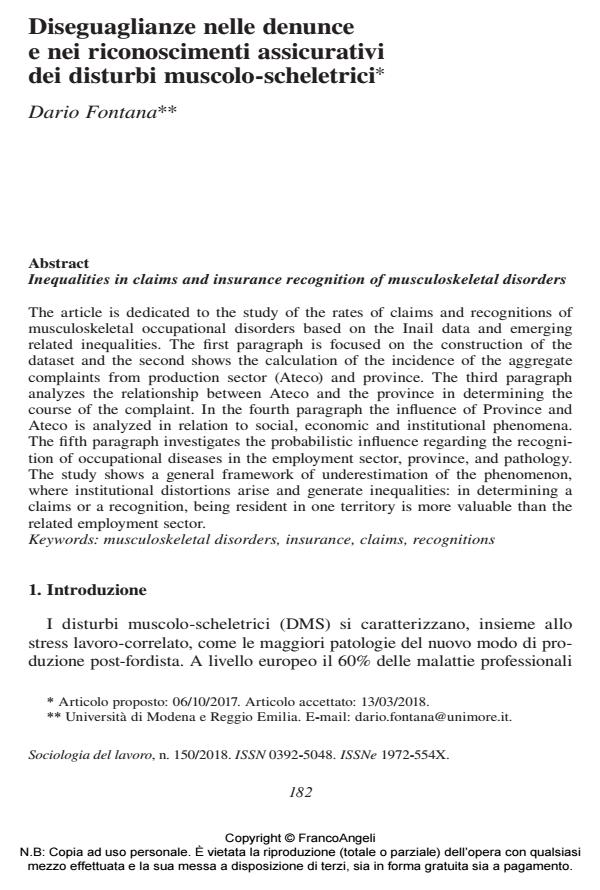Inequalities in claims and insurance recognition of musculoskeletal disorders
Journal title SOCIOLOGIA DEL LAVORO
Author/s Dario Fontana
Publishing Year 2018 Issue 2018/150
Language Italian Pages 20 P. 182-201 File size 220 KB
DOI 10.3280/SL2018-150010
DOI is like a bar code for intellectual property: to have more infomation
click here
Below, you can see the article first page
If you want to buy this article in PDF format, you can do it, following the instructions to buy download credits

FrancoAngeli is member of Publishers International Linking Association, Inc (PILA), a not-for-profit association which run the CrossRef service enabling links to and from online scholarly content.
The article is dedicated to the study of the rates of claims and recognitions of musculoskeletal occupational disorders based on the Inail data and emerging related inequalities. The first paragraph is focused on the construction of the dataset and the second shows the calculation of the incidence of the aggregate complaints from production sector (Ateco) and province. The third paragraph analyzes the relationship between Ateco and the province in determining the course of the complaint. In the fourth paragraph the influence of Province and Ateco is analyzed in relation to social, economic and institutional phenomena. The fifth paragraph investigates the probabilistic influence regarding the recognition of occupational diseases in the employment sector, province, and pathology. The study shows a general framework of underestimation of the phenomenon, where institutional distortions arise and generate inequalities: in determining a claims or a recognition, being resident in one territory is more valuable than the related employment sector.
Keywords: Musculoskeletal disorders, insurance, claims, recognitions
- Predictive validity of an indicator of exposure to unfavorable ergonomic working conditions on work-related musculoskeletal disorders Dario Fontana, Chiara Ardito, Giuseppe Costa, Barbara Boschetto, Angelo d’Errico, in Quality & Quantity /2023 pp.4545
DOI: 10.1007/s11135-022-01552-0 - Job quality in worker cooperatives: Beyond degeneration and intrinsic rewards Lisa Dorigatti, Francesco E. Iannuzzi, Valeria Piro, Devi Sacchetto, in British Journal of Industrial Relations /2024 pp.591
DOI: 10.1111/bjir.12798
Dario Fontana, Diseguaglianze nelle denunce e nei riconoscimenti assicurativi dei disturbi muscolo-scheletrici in "SOCIOLOGIA DEL LAVORO " 150/2018, pp 182-201, DOI: 10.3280/SL2018-150010